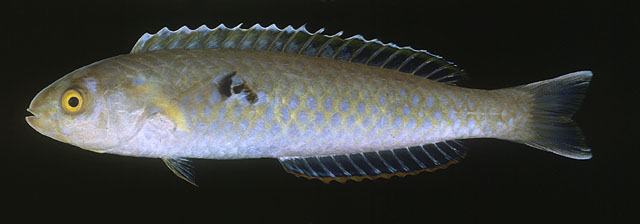| Labridae (Wrasses), subfamily: Xyrichtyinae |
| 9.41 cm SL (male/unsexed) |
|
benthopelagic; marine; depth range 7 - 18 m |
| Eastern Central Pacific: known only from O'ahu, Hawaiian Islands. |
|
Dorsal spines (total): 9-9; Dorsal soft rays (total): 12-12; Anal spines: 3-3; Anal soft rays: 12-12; Vertebrae: 25-25. Flexible anal fin spines; 19 or 20 + 5 or 6 pored lateral line scales with single horizontal tubule, ending in a pore; scales thin and rhomboidal, those of thorax and anterior abdomen smaller than those of side of body; head naked except for 2 small scales dorsally on opercle and diagonal row of 5 partially embedded scales behind eye; no median predorsal scales; 3 small median prepelvic scales; anterior third of prepelvic region naked; branchiostegal rays 6; upper jaw strongly protrusible, median process of premaxilla extending to above anterior pupil edge; body moderately elongate, the depth 4.2-4.45 in SL; dorsal part of head from front of snout to origin of dorsal fin with a fleshy median ridge, the interorbital space high and triangular when viewed from the front; interorbital space narrowest anteriorly; caudal fin small, 1.45-1.65 in head length; pelvic fins small, 2.2-3.05 in head length (Ref. 26794). |
| Adults are found over open sand bottom, in small, swift-swimming schools (Ref. 26794). Feed on zooplankton above the substratum (Ref. 26794, 58466). Oviparous, distinct pairing during breeding (Ref. 205). |
|
Least Concern (LC); Date assessed: 12 July 2008 Ref. (130435)
|
| harmless |
Source and more info: www.fishbase.org. For personal, classroom, and other internal use only. Not for publication.

